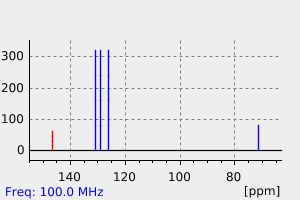bis(3-selenienyl)methanol | 691411-96-8
中文名称
——
中文别名
——
英文名称
bis(3-selenienyl)methanol
英文别名
Uowyqnxgrsnhfl-uhfffaoysa-;di(selenophen-3-yl)methanol
CAS
691411-96-8
化学式
C9H8OSe2
mdl
——
分子量
290.082
InChiKey
UOWYQNXGRSNHFL-UHFFFAOYSA-N
BEILSTEIN
——
EINECS
——
-
物化性质
-
计算性质
-
ADMET
-
安全信息
-
SDS
-
制备方法与用途
-
上下游信息
-
文献信息
-
表征谱图
-
同类化合物
-
相关功能分类
-
相关结构分类
计算性质
-
辛醇/水分配系数(LogP):0.88
-
重原子数:12
-
可旋转键数:2
-
环数:2.0
-
sp3杂化的碳原子比例:0.11
-
拓扑面积:20.2
-
氢给体数:1
-
氢受体数:1
上下游信息
-
下游产品
中文名称 英文名称 CAS号 化学式 分子量 —— 2,2-bis(3-selenienyl)-1,3-dioxolane 691411-97-9 C11H10O2Se2 332.119
反应信息
-
作为反应物:描述:bis(3-selenienyl)methanol 在 吡啶 、 chromium(VI) oxide 、 叔丁基锂 、 对甲苯磺酸 作用下, 以 四氢呋喃 、 正戊烷 、 苯 为溶剂, 反应 62.33h, 生成 2,2-bis(2-iodo-3-selenienyl)-1,3-dioxolane参考文献:名称:Synthesis, Crystal Structures, and Electrical Properties of Anion Radical Salts of Novel Electron Acceptors, 2,6-Dicyanomethylene-4-oxo-2,6-dihydrocyclopentadithiophene (CPDT-TCNQ) and Its Diselenophene Analogue (CPDS-TCNQ), Having Three Electron-Withdrawing Groups摘要:ion离子。DOI:10.1246/bcsj.77.463
-
作为产物:描述:3-formylselenophene 、 3-溴硒吩 在 正丁基锂 作用下, 以 乙醚 、 正己烷 为溶剂, 反应 2.83h, 以80%的产率得到bis(3-selenienyl)methanol参考文献:名称:Synthesis, Crystal Structures, and Electrical Properties of Anion Radical Salts of Novel Electron Acceptors, 2,6-Dicyanomethylene-4-oxo-2,6-dihydrocyclopentadithiophene (CPDT-TCNQ) and Its Diselenophene Analogue (CPDS-TCNQ), Having Three Electron-Withdrawing Groups摘要:ion离子。DOI:10.1246/bcsj.77.463
表征谱图
-
氢谱1HNMR
-
质谱MS
-
碳谱13CNMR
-
红外IR
-
拉曼Raman
-
峰位数据
-
峰位匹配
-
表征信息
同类化合物
硒酚
硒吩并[3,2-B]噻吩
硒吩-3-羧酸
硒吩-2-羧酸
硒吩-2-硼酸
5-甲基-2-硒吩羰基氯化物
5-甲基-2-硒吩亚磺酸
3-硒吩羰基氯化物
3-甲基硒吩
3,4-双(氯甲基)-2,5-二甲基硒吩
2-甲基-硒吩
2-乙烯基硒吩
2,5-二-(2'-噻吩基)硒吩
2,2'-双硒
2,6-di(selenophen-2-yl)tetrahydro-4H-selenopyran-4-one
2-(2-(selenophen-2-yl)ethynyl)selenophene
(2-selenophene-2-yl)lithium
2-(dec-1-ynyl)selenophene
(3-selenienyl)di(1-adamantyl)methanol
5-Methyl-2-mercapto-selenophen
seleno[3,4-b]thiophene
3-Selenophenethiol, 2,5-dimethyl-
2-dicyanomethylselenophene
bis(3-selenienyl)methanol
2-Propyl-selenophen
2-(5'-hydroxymethyl-2'-selenyl)-thiophene
4,4,6,6-tetramethyl-2-{[(methylsulfonyl)thio]methyl}-4,6-dihydro-5H-selenolo[2,3-c]pyrrol-5-yloxyl radical
selenosulflower
5-Carboxyseleno<2,3-b>thiophen
methyl 4-[(dimethylamino)diazenyl]-5-methylselenophene-2-carboxylate
ethyl selenopheno[3,2-b]thiophene-5-carboxylate
3-Cyanoselenophen
2,4-Ditert-butylselenophene
5-Hydroxymethyl-selenophen-2-carbonsaeure
1,3-Dithiolo<4,5-c>selenophene-2-thione
methyl 3-amino-5-(methoxycarbonyl)selenophene-2-carboxylate
tetramethyl 2,3,4,5-selenophenetetracarboxylate
2,2'-{5,5'-[5,5'-(selenophene-2,5-diyl)bis(3,4-dibutylthien-5,2-diyl)]bis-(selenophene-5,2-diyl)}bis(methan-1-yl-1-ylidene)dimalononitrile
2-(2-bromoethylsulfonyl)selenophene
2-(4,4-bis(methoxymethyl)-7-(selenophen-2-yl)hepta-1,6-diynyl)selenophene
cyclopenta[c]selenophene-(CH2OMe)2
2-[5,5-Bis(methoxymethyl)-3-thiophen-2-yl-4,6-dihydrocyclopenta[c]selenophen-1-yl]thiophene
3,6-dimethylselenolo<3,2-b>selenophene
2,5-Bis(2-selenienyl)furan
tetramethyl-selenophene
2,3,4-trimethyl-selenophene
2,3,5-trimethyl-selenophene
selenophen-2-yl-methanol
1-selenophen-2-yl-ethanol
2-carbomethoxyselenophene







